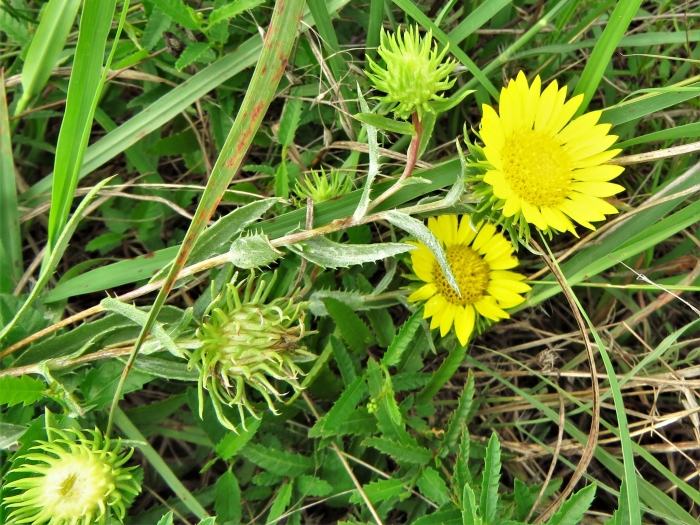Narrowleaf Gumweed
(Grindelia lanceolata)
Narrowleaf Gumweed (Grindelia lanceolata)
/
/

Annika Lindqvist
CC BY 4.0
Image By:
Annika Lindqvist
Recorded By:
Copyright:
CC BY 4.0
Copyright Notice:
Photo by: Annika Lindqvist | License Type: CC BY 4.0 | License URL: http://creativecommons.org/licenses/by/4.0/ | Rights Holder: Annika Lindqvist | Publisher: iNaturalist | Date Created: 2020-09-11T16:03:10-07:00 |




















































Estimated Native Range
Summary
Grindelia lanceolata, commonly known as Narrowleaf Gumweed, is a biennial or short-lived perennial subshrub or herb that is native to open prairies and grasslands, as well as open forests in the Central and Southeastern United States and Mexico. It can grow up to 150 cm (5 feet) tall and is characterized by its narrow leaves, which are up to 11 cm (4.4 inches) long and typically have few or no hairs. During the summer, Narrowleaf Gumweed produces showy yellow flower heads, often arranged in flat-topped clusters, though sometimes singly on a stalk. Each head consists of 12-36 ray flowers encircling numerous disc flowers, attracting pollinators such as bees and butterflies.
Narrowleaf Gumweed is valued for its drought tolerance and its ability to thrive in poor soils, making it a suitable choice for xeriscaping and naturalized areas. It is also used for erosion control due to its extensive root system. In cultivation, it prefers full sun exposure and can tolerate low to medium water conditions, making it a low-maintenance plant for gardeners. It is adaptable to a range of soil types, provided they have slow to medium drainage. While not commonly found in ornamental gardens, its bright yellow flowers can add a splash of color to wildflower meadows or prairie restorations.CC BY-SA 4.0
Narrowleaf Gumweed is valued for its drought tolerance and its ability to thrive in poor soils, making it a suitable choice for xeriscaping and naturalized areas. It is also used for erosion control due to its extensive root system. In cultivation, it prefers full sun exposure and can tolerate low to medium water conditions, making it a low-maintenance plant for gardeners. It is adaptable to a range of soil types, provided they have slow to medium drainage. While not commonly found in ornamental gardens, its bright yellow flowers can add a splash of color to wildflower meadows or prairie restorations.CC BY-SA 4.0
Plant Description
- Plant Type: Subshrub, Herb
- Height: 2-3 feet
- Width: 1.5-2 feet
- Growth Rate: Moderate
- Flower Color: Yellow
- Flowering Season: Summer, Fall
- Leaf Retention: Evergreen
Growth Requirements
- Sun: Full Sun
- Water: Low, Medium
- Drainage: Slow, Medium
Common Uses
Bee Garden, Bird Garden, Butterfly Garden, Drought Tolerant, Low Maintenance, Rock Garden
Natural Habitat
native to open prairies and grasslands, as well as open forests in the Central and Southeastern United States and Mexico
Other Names
Common Names: Texan Gumweed, Gulf Gumweed, Spiny Toothed Gumweed
Scientific Names: , Grindelia lanceolata, Grindelia littoralis, Grindelia lanceolata f. latifolia, Grindelia lanceolata f. lanceolata, Grindelia texana subsp. lanceolata, Grindelia texana var. texana, Hoorebekia lanceolata,
GBIF Accepted Name: Grindelia lanceolata Nutt.